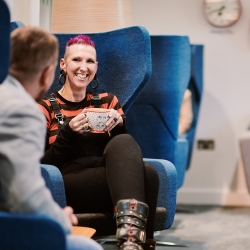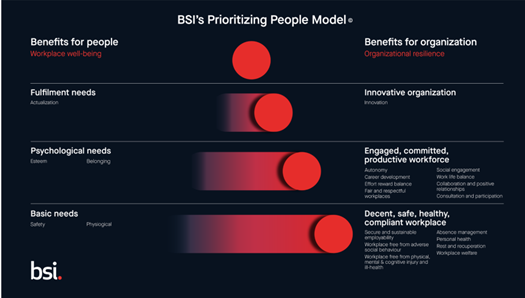 Since offices reopened, there has naturally been a much greater focus on health and safety. Office managers everywhere have deployed one-way corridors, anti-viral disinfectant wipes, and daily temperature checks in order to ensure that those who have returned to the office feel safe. Globally, businesses have learned to cope with these adverse circumstances, but there are other lessons from the past year that we should use to refresh the workplace as well.
Since offices reopened, there has naturally been a much greater focus on health and safety. Office managers everywhere have deployed one-way corridors, anti-viral disinfectant wipes, and daily temperature checks in order to ensure that those who have returned to the office feel safe. Globally, businesses have learned to cope with these adverse circumstances, but there are other lessons from the past year that we should use to refresh the workplace as well.
Against most expectations, a year of working from home actually increased the trust between people and their employers, as a “we’re all in this together” mentality took over. Productivity remained high, or increased, and the way was paved for a new approach that recognizes that people are critical to an organizations’ long-term survival. Importantly, BSI’s Organizational Resilience Index 2021 found that organizations that prioritized the health, safety and wellbeing of employees, clients and communities over the last year were more resilient, not only weathering the disruption but going on to build back better more quickly. Flourishing workers who feel fulfilled are at the centre of resilient organizations.
As corporate memory of the pandemic fades – and hybrid and remote working models become the norm for some organizations – we need to ensure that organizations and their leaders do not lose sight of the business costs of failing to prioritize people. The definition of the workplace may have expanded but the need for that culture of trust remains the same. That’s why models such as BSI’s Prioritizing People Model are increasingly important in helping organizations navigate the ‘next normal’.
Prioritizing People
The Prioritizing People Model is intended to make the link between organizational resilience and a focus on health, safety, and wellbeing explicit. It is based on the idea that if employees’ psychological and fulfilment needs are being met on top of their basic needs, they will be much more engaged, committed, productive, and innovative. More importantly, the model should not be thought of as a set of initiatives to be ‘checked off’ a list. Wellness initiatives like exercise classes in the office or free fruit at breakfast have been found to improve health and wellness in the workplace, but only in the short term and they do not address the wider fulfilment needs to create positive workplace wellbeing. To create long-lasting change, the model has to be embedded in the values and behaviours of the organization. Corporate DNA must be restructured so that employees’ needs are considered at every level.

At the base of the model sits a workforce’s basic needs; ultimately, a safe and clean physical and social environment in which to work. The responsibility of workplaces to provide for this is uncontroversial, but its provision acts as a basic grounding for the other psychological and fulfilment needs. It may seem surprising but even in today’s world, basic workplace welfare is often overlooked. Whilst cleanliness, hygiene and ventilation has finally received the attention it needed thanks to COVID-19, other areas such as suitable lighting, thermal comfort and even clean drinking water are still often lacking. It’s also important to understand that failing in basic welfare provision can have knock on impacts of psychological health – feeling too hot or cold can lead to workplace stress; as can having insufficient numbers of toilets or toilets that are too far away to access during breaks, which is too often the case, particularly for female and disabled workers.
Beyond the physical space, organizations need to shift their approach on health, safety, and wellbeing away from being a compliance issue to an investment that pays off in the long run. Proactive approaches that prioritize prevention over mitigation, and continuous improvement over immutability are needed. This is delivered by implementing an occupational health and safety management system that manages not only physical health and safety but also psychological health such as mental and cognitive risks.
Raising the bar
Beyond the pandemic, communities around the world have had to cope with a lot of change. Generation Z are demanding action on climate change as a global focus on ESG issues spreads, social movements like #MeToo and BLM drive the diversity and inclusion (D&I) agenda, and governments are increasingly concerned about the social burden of mental illness, obesity, and chronic illnesses. With all of these mounting pressures, workplaces should be taking steps to help improve employees’ physical and psychological health and fulfil individual potential.
Psychological needs often take the shape of employees’ feelings of belonging or esteem, reinforcing their psychological health by helping them to feel like valued members of a community. It is also about preventing workplace risk that can harm psychological health such as bullying, harassment, lack of control or poor work life balance. Psychological needs can be met by organizations taking measures to encourage sets of good relationships that provide the ‘social capital’ which individuals need to maintain good mental health and engagement.
Things which organizations should be encouraging in order to meet these psychological needs are include:
- Collaborative, communicative, emotionally intelligent leadership
- Diverse, inclusive and ethical workplace relationships that are based on respect and fairness
- Opportunities for lifelong learning and employability
- A balanced effort and reward ratio
- Work and workplaces that prevent physical and mental harm and promote good physical and psychological health
- Creating workplace and community social capital
Provision for a workforce’s psychological needs and helping them to feel valued and empowered to work will lay the groundwork for the provision for their fulfilment needs, and make the organization more resilient.
Getting Innovative
Fulfilment needs are also an incredibly important aspect of the model as well. The authors of the EU’s 6th working conditions survey write that “work is an instrument through which individuals grow, develop and become themselves” and that the conditions of work are crucial for achieving self-fulfilment”. Employees’ self-actualization (the core of fulfilment and wellbeing) is driven by the ability to continue to grow, be creative and adapt. Ultimately, meeting these needs unlocks a workforce’s capacity for innovation, delivering unique benefits to an organization.
The potential for innovation is only possible if all other aspects of the model are in place though. Innovation involves an inherent amount of risk, and risk cannot be overcome without trust. More importantly, the more risk that an organization can overcome, the more resilient it is. Whatever the ‘next normal’ is, organizations should be navigating it equipped with the tools necessary to keeping and building their employees’ trust.
Kate Field is Global Head of Health, Safety, and Wellbeing, BSI














September 23, 2021
Resilient companies need the trust of their employees more than ever
by Kate Field • Comment, Workplace
Against most expectations, a year of working from home actually increased the trust between people and their employers, as a “we’re all in this together” mentality took over. Productivity remained high, or increased, and the way was paved for a new approach that recognizes that people are critical to an organizations’ long-term survival. Importantly, BSI’s Organizational Resilience Index 2021 found that organizations that prioritized the health, safety and wellbeing of employees, clients and communities over the last year were more resilient, not only weathering the disruption but going on to build back better more quickly. Flourishing workers who feel fulfilled are at the centre of resilient organizations.
As corporate memory of the pandemic fades – and hybrid and remote working models become the norm for some organizations – we need to ensure that organizations and their leaders do not lose sight of the business costs of failing to prioritize people. The definition of the workplace may have expanded but the need for that culture of trust remains the same. That’s why models such as BSI’s Prioritizing People Model are increasingly important in helping organizations navigate the ‘next normal’.
Prioritizing People
The Prioritizing People Model is intended to make the link between organizational resilience and a focus on health, safety, and wellbeing explicit. It is based on the idea that if employees’ psychological and fulfilment needs are being met on top of their basic needs, they will be much more engaged, committed, productive, and innovative. More importantly, the model should not be thought of as a set of initiatives to be ‘checked off’ a list. Wellness initiatives like exercise classes in the office or free fruit at breakfast have been found to improve health and wellness in the workplace, but only in the short term and they do not address the wider fulfilment needs to create positive workplace wellbeing. To create long-lasting change, the model has to be embedded in the values and behaviours of the organization. Corporate DNA must be restructured so that employees’ needs are considered at every level.
At the base of the model sits a workforce’s basic needs; ultimately, a safe and clean physical and social environment in which to work. The responsibility of workplaces to provide for this is uncontroversial, but its provision acts as a basic grounding for the other psychological and fulfilment needs. It may seem surprising but even in today’s world, basic workplace welfare is often overlooked. Whilst cleanliness, hygiene and ventilation has finally received the attention it needed thanks to COVID-19, other areas such as suitable lighting, thermal comfort and even clean drinking water are still often lacking. It’s also important to understand that failing in basic welfare provision can have knock on impacts of psychological health – feeling too hot or cold can lead to workplace stress; as can having insufficient numbers of toilets or toilets that are too far away to access during breaks, which is too often the case, particularly for female and disabled workers.
Beyond the physical space, organizations need to shift their approach on health, safety, and wellbeing away from being a compliance issue to an investment that pays off in the long run. Proactive approaches that prioritize prevention over mitigation, and continuous improvement over immutability are needed. This is delivered by implementing an occupational health and safety management system that manages not only physical health and safety but also psychological health such as mental and cognitive risks.
Raising the bar
Beyond the pandemic, communities around the world have had to cope with a lot of change. Generation Z are demanding action on climate change as a global focus on ESG issues spreads, social movements like #MeToo and BLM drive the diversity and inclusion (D&I) agenda, and governments are increasingly concerned about the social burden of mental illness, obesity, and chronic illnesses. With all of these mounting pressures, workplaces should be taking steps to help improve employees’ physical and psychological health and fulfil individual potential.
Psychological needs often take the shape of employees’ feelings of belonging or esteem, reinforcing their psychological health by helping them to feel like valued members of a community. It is also about preventing workplace risk that can harm psychological health such as bullying, harassment, lack of control or poor work life balance. Psychological needs can be met by organizations taking measures to encourage sets of good relationships that provide the ‘social capital’ which individuals need to maintain good mental health and engagement.
Things which organizations should be encouraging in order to meet these psychological needs are include:
Provision for a workforce’s psychological needs and helping them to feel valued and empowered to work will lay the groundwork for the provision for their fulfilment needs, and make the organization more resilient.
Getting Innovative
Fulfilment needs are also an incredibly important aspect of the model as well. The authors of the EU’s 6th working conditions survey write that “work is an instrument through which individuals grow, develop and become themselves” and that the conditions of work are crucial for achieving self-fulfilment”. Employees’ self-actualization (the core of fulfilment and wellbeing) is driven by the ability to continue to grow, be creative and adapt. Ultimately, meeting these needs unlocks a workforce’s capacity for innovation, delivering unique benefits to an organization.
The potential for innovation is only possible if all other aspects of the model are in place though. Innovation involves an inherent amount of risk, and risk cannot be overcome without trust. More importantly, the more risk that an organization can overcome, the more resilient it is. Whatever the ‘next normal’ is, organizations should be navigating it equipped with the tools necessary to keeping and building their employees’ trust.
Kate Field is Global Head of Health, Safety, and Wellbeing, BSI